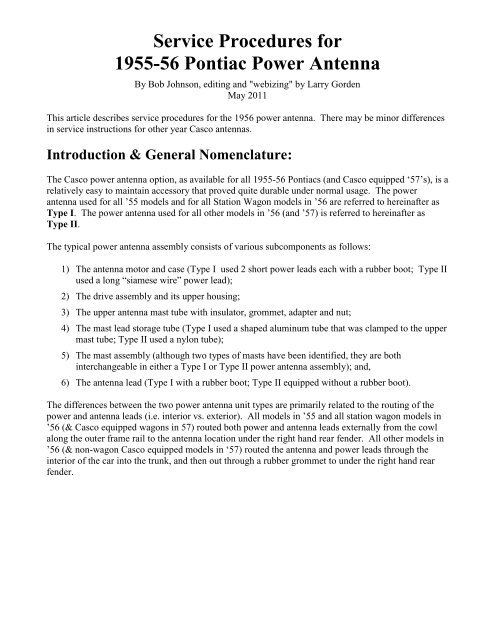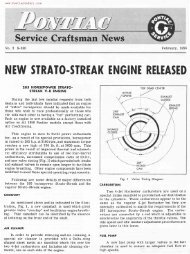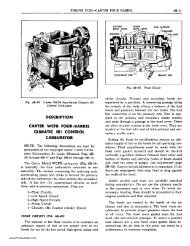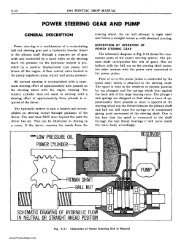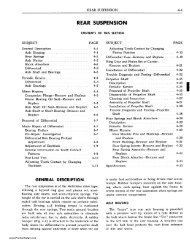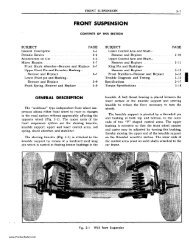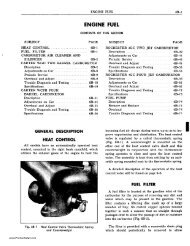Power Antenna - Pontiac Custom Safari 55 56 & 57
Power Antenna - Pontiac Custom Safari 55 56 & 57
Power Antenna - Pontiac Custom Safari 55 56 & 57
Create successful ePaper yourself
Turn your PDF publications into a flip-book with our unique Google optimized e-Paper software.
Service Procedures for<br />
19<strong>55</strong>-<strong>56</strong> <strong>Pontiac</strong> <strong>Power</strong> <strong>Antenna</strong><br />
By Bob Johnson, editing and "webizing" by Larry Gorden<br />
May 2011<br />
This article describes service procedures for the 19<strong>56</strong> power antenna. There may be minor differences<br />
in service instructions for other year Casco antennas.<br />
Introduction & General Nomenclature:<br />
The Casco power antenna option, as available for all 19<strong>55</strong>-<strong>56</strong> <strong>Pontiac</strong>s (and Casco equipped „<strong>57</strong>‟s), is a<br />
relatively easy to maintain accessory that proved quite durable under normal usage. The power<br />
antenna used for all ‟<strong>55</strong> models and for all Station Wagon models in ‟<strong>56</strong> are referred to hereinafter as<br />
Type I. The power antenna used for all other models in ‟<strong>56</strong> (and ‟<strong>57</strong>) is referred to hereinafter as<br />
Type II.<br />
The typical power antenna assembly consists of various subcomponents as follows:<br />
1) The antenna motor and case (Type I used 2 short power leads each with a rubber boot; Type II<br />
used a long “siamese wire” power lead);<br />
2) The drive assembly and its upper housing;<br />
3) The upper antenna mast tube with insulator, grommet, adapter and nut;<br />
4) The mast lead storage tube (Type I used a shaped aluminum tube that was clamped to the upper<br />
mast tube; Type II used a nylon tube);<br />
5) The mast assembly (although two types of masts have been identified, they are both<br />
interchangeable in either a Type I or Type II power antenna assembly); and,<br />
6) The antenna lead (Type I with a rubber boot; Type II equipped without a rubber boot).<br />
The differences between the two power antenna unit types are primarily related to the routing of the<br />
power and antenna leads (i.e. interior vs. exterior). All models in ‟<strong>55</strong> and all station wagon models in<br />
‟<strong>56</strong> (& Casco equipped wagons in <strong>57</strong>) routed both power and antenna leads externally from the cowl<br />
along the outer frame rail to the antenna location under the right hand rear fender. All other models in<br />
‟<strong>56</strong> (& non-wagon Casco equipped models in „<strong>57</strong>) routed the antenna and power leads through the<br />
interior of the car into the trunk, and then out through a rubber grommet to under the right hand rear<br />
fender.
These photos illustrate the two antenna types:<br />
<strong>Power</strong> <strong>Antenna</strong> – Type I<br />
19<strong>55</strong> All Models<br />
19<strong>56</strong> Station Wagons Only<br />
Mast Lead Aluminum Storage Tube<br />
Upper End of storage tube clamps to antenna<br />
mast tube<br />
Crimped end of storage tube with drain at bottom<br />
loop of tube<br />
Short power leads with rubber boots<br />
<strong>Power</strong> <strong>Antenna</strong> –Type II<br />
19<strong>56</strong> All models except Station Wagon<br />
Mast Lead Nylon Storage Tube<br />
Storage Tube clips to fuel tank flange<br />
Felt filter in drainage end of tube<br />
Long siamese power lead, no boots<br />
General Service Procedures:<br />
The most common cause of failure for the power antenna unit is a broken, bent or stuck mast.<br />
Primarily due to operator error or abuse, failure of the mast was often followed buy failure of the<br />
electric motor and/or drive mechanism.<br />
I say this because, unlike modern cars, these older power antenna units do not have an automatic stop<br />
(i.e. shut off) at the end of travel for the mast. If the toggle switch isn‟t release as soon as the mast<br />
reaches its end of travel (either up or down), damage to the unit can result. Potential damage includes<br />
a worn, warped or broken nylon mast lead; a stripped gear or gears in the drive mechanism, or even a<br />
burned out/shorted electric motor, any one of which can ruin an otherwise serviceable unit.<br />
Damage to the nylon mast lead caused by the switch being held too long with the mast fully raised, is<br />
generally characterized by a permanent “warping” of the lead and/or a heavy wear point in the lead<br />
near its lower end.
By contrast, damage to the nylon mast lead caused by the switch being held too long with the mast<br />
fully lowered is characterized by stripped gears, a badly worn spot at the nylon leads upper end, or<br />
even a broken lead. Worn spots in the nylon lead can result in the mast not travelling either up or<br />
down past the worn spot. It just slips unless the adjustment screw and spring tension is increased.<br />
However, increasing the tension on the drive mechanism can cause undue wear and tear on the drive<br />
unit and its gears, accelerate wear on the lead, and can even cause the nylon lead to break if the mast is<br />
lowered and the switch is not promptly released. The thin worn spot in the lead simply snaps. That‟s<br />
the end of that mast!<br />
Obviously, operation of the power antenna motor with a broken, bent or stuck mast is highly risky, and<br />
is not recommended. If you have a bent, broken or stuck mast, before attempting to operate the<br />
antenna electric motor (even for testing purposes) it is best to either remove the mast entirely, or at<br />
least relieve all tension on the nylon mast lead by completely removing the tension screw and spring<br />
from the drive mechanism. The adjustment screw is located in the upper drive mechanism case near<br />
the top (see photo below).<br />
Adjustment Screw<br />
As can be seen in the first photo, this screw is often caked with dirt, grease or even undercoating<br />
material. So, remove all the gunk to reveal the face of the screw. I‟ve found a stub handle straight<br />
bladed screw driver with a broad blade works best for adjusting this screw.<br />
Adjustment screw and tension spring<br />
After the adjustment screw and spring are removed, it is much safer to test the electric motor and/or<br />
antenna mast for proper operation.
Bench Testing the Motor:<br />
The motor receives power through a two wire electrical lead; one wire for each direction of mast travel<br />
(up or down).<br />
The circuit is completed by the grounding of the antenna motor case through the lower mounting stud<br />
(and when installed on the car, then through the mounting bracket and its attachment to the lower<br />
fender of the car …good to know when trouble shooting an inoperative antenna unit that‟s still on the<br />
car…remember to check first for good grounding before removing the unit).<br />
The electric motor can be readily bench tested by connecting either wire of the power lead to the<br />
positive side of a 12 volt battery, and connecting the mounting stud on the bottom of the motor case to<br />
the negative side of the battery. Both wires of the power lead need to be tested to confirm proper<br />
operation of the electric motor in both directions. Remember to completely remove the tension<br />
adjustment screw and spring from the drive mechanism as described above. With these removed, a<br />
properly functioning motor should readily spin in both directions without any damage to the unit.<br />
Bench Testing the Mast:<br />
With the adjustment screw and tension spring removed, the mast can be raised and lowered by hand to<br />
test its ease of travel. If the mast sections show any signs of undue drag, do not force them. Instead,<br />
first lightly oil them to see if this relieves the drag and provides smoother operation. If not, there may<br />
be a problem either within the drive mechanism or possibly unusually heavy dirt and grime deposits<br />
within the storage tube of the antenna unit. If after lightly lubricating the mast, any undue drag is<br />
found, check both the nylon lead storage tube and/or the drive mechanism for possible problems.<br />
Checking the <strong>Antenna</strong> Mast Nylon Lead and Mast Assembly:<br />
With the antenna assembly removed from the vehicle, subsequent removal of the storage tube will<br />
allow the nylon mast lead to be checked for any damage along most of its length (except that portion<br />
remaining within the drive mechanism). Remove the two screws that hold the storage tube to the<br />
lower side of the motor case (and the clamp that holds the storage tube to the antenna mast tube on<br />
Type I antennas). The tube should then readily slide off of the nylon mast lead itself. Handle the nylon<br />
lead gently; be careful not to kink or twist it, as this may snap the lead and render the mast unusable.
The above photos show the screws that secure the storage tube to the antenna motor assembly for the<br />
Type II antenna as used on the sedan, hardtop and convertible models.<br />
The aluminum storage tube for Type I antennas as used on station wagons is similarly secured to the<br />
motor, as well as clamped to the upper mast tube assembly. For station wagons, the clamp holding the<br />
aluminum storage tube to the upper antenna mast tube will also need to be removed.<br />
These photos show the connection of the clamp to the upper antenna mast tube and aluminum storage<br />
tube.<br />
Inspect the nylon mast lead for signs of damage. A broken lead will immediately be apparent, but also<br />
look for any worn spots or warped areas along the length of the lead. Worn or warped sections can<br />
affect proper operation of the unit.<br />
Example of permanently warped nylon mast lead; shows<br />
light warp damage.<br />
A broken, badly worn or heavily warped mast lead generally means you‟ll need to replace the mast<br />
(that is, unless you can figure out a way to replace just the nylon lead). A lightly worn or warped lead<br />
might be salvageable with proper adjustment of the drive mechanism tension. If you find any<br />
resistance in removing the protection tube from the mast lead, again, whatever you do, don‟t force it.<br />
Try feeding some light weight oil (WD 40 or 3-in-1) into the tube to hopefully loosen and clear any<br />
dirt or debris that may be causing the lead to stick. The nylon lead is somewhat easy to damage, and if<br />
kinked can snap-in-two in a heart beat, in which case the mast is no longer usable. So, handle with<br />
care. If the lead readily slides out of the protection tube, but the mast is still showing resistance when<br />
operated manually, there may be a problem either within the drive mechanism or the mast itself.
Checking the Drive Mechanism:<br />
With the tension adjustment screw and spring removed, and the mast lead protection tube removed, the<br />
next area to check is the drive mechanism. The antenna electric motor and drive mechanism are<br />
enclosed within three case pieces, the upper drive mechanism cover, the upper electric motor cover,<br />
and the lower electric motor cover. The electric motor power lead exits the upper and lower electric<br />
motor cases where they separate. The drive mechanism cover is fastened to the upper electric motor<br />
case and can be opened by removing the three round head screws found on the top of the mechanism<br />
cover (two at 1” length, one at 1-1/2” length). It is not recommended that the hobbyist ever open the<br />
upper and lower electric motor cases. Any work needed on the electric motor should be done by a paid<br />
professional.<br />
The drive mechanism cover, as shown in this photo, is that portion of the motor case that is dark black,<br />
as compared to the upper antenna mast tube and the upper & lower electric motor case sections which<br />
by contrast are a dirty brown color on this particular motor assembly.<br />
With the three screws removed, the upper case (together with the upper mast tube and mast assembly)<br />
should readily come off the motor case and the nylon lead should slide out of the motor case.<br />
If the mast lead is exhibiting any drag, open this case cover cautiously so as to avoid further damage to<br />
the mast lead. Rather than simply pulling the top section away, first try pushing the mast lead up from<br />
the bottom of the motor case into the drive mechanism to see if the mast will slide up some. If so, you<br />
can then raise the cover by the distance the mast has moved up by pushing the mast section down<br />
while pulling the case top up (hold the lead in place at the bottom of the motor case so it doesn‟t slide<br />
back out). With the drive mechanism case raised slightly, you should then be able to see inside it to<br />
determine whether anything inside the cover is causing the resistance on the antenna lead and<br />
hopefully relieve the problem so the entire lead can be pulled out through the drive mechanism.<br />
Sometimes the lead has simply become twisted and has turned ninety degrees and wedged between the<br />
two steel wheels it‟s designed to run between. The narrow sides of the lead do not run on the steel<br />
wheels. Rather, the wide sides are supposed to run against the wheels.
Nylon lead end view<br />
Drive mechanism<br />
Although, the wheels are slotted in such a way that it looks logical that the lead might run with the<br />
narrow sides against the wheels and the lead being in the two notches….this is incorrect!. Not to say<br />
you won‟t find it that way upon disassembly…as sometimes the lead gets twisted or may have been<br />
incorrectly installed. If installed incorrectly, the tension spring will not provide sufficient tension for<br />
the mast to work properly as the running surfaces will be too narrow.<br />
Once the upper case and mast assembly and the mast lead have been removed from the drive<br />
mechanism, check the drive mechanism for undue wear, damaged or stripped gears, excessive dirt,<br />
grim, etc. Any damaged parts will need to be replaced and the mechanism properly lubricated. Note<br />
the three felt-wick locations where light weight oil should be applied to lubricate the bearing surfaces<br />
of the gear/wheel shafts. Once all parts have been cleaned and lubricated, and damaged parts replaced,<br />
the motor should be re-tested to ensure all drive mechanism parts are operating properly. When<br />
reassembling the antenna, ensure the mast lead is inserted between the two steel drive wheels with the<br />
wide sides of the lead in contact with the wheel surfaces. If you inspect the lead closely, you‟ll see the<br />
wide surfaces are actually not flat, but have a ridge running down their centers so the lead is somewhat<br />
diamond shaped (actually a squashed hexagon) in cross section. These ridges are what should be<br />
centered on the notches in the two steel drive wheels.<br />
Removal of <strong>Antenna</strong> Mast:<br />
Step One – Disassembly of Upper Drive Mechanism Cover and <strong>Antenna</strong> Tube: With the upper<br />
drive mechanism cover and antenna tube and mast assembly removed, the mast tube can be<br />
disassembled from the drive mechanism case by removing the three ¼” long round head sheet metal<br />
screws that hold the tube to the case. Gingerly twist the tube free from the upper case being careful not<br />
to twist or kink the nylon lead. Slide the full length of the nylon lead out of the upper case. You<br />
should find a grommet and specialized brass washer in the top tube of the drive mechanism case,
and another mating grommet in the lower end of the antenna tube.<br />
This antenna mast is a replacement type, and differs slightly from the original equipment<br />
mast. The base of an original mast has two square tabs 180 degrees apart that mate to the two<br />
notches in the brass washer that seats in the grommet found in the drive mechanism case.<br />
Carefully note their relative positions, and how the brass washer mates to the bottom of the antenna<br />
mast. Both grommets and the washer should be removed, cleaned and waxed in preparation for<br />
reassembly of the mast. Do not attempt to remove the mast assembly from the antenna tube before<br />
disconnecting the antenna lead wire.<br />
Step Two – <strong>Antenna</strong> Cable Lead Removal: Remove the antenna cable lead from the upper antenna<br />
tube. There are a couple of ways this can be done. The antenna lead is attached to a special bracket on<br />
the upper tube by a fine threaded screw collar. This collar is an aluminum piece, and the bracket to<br />
which it is attached is a steel bracket.<br />
Aluminum collar<br />
Steel bracket
Consequently, due to corrosion problems associated with dissimilar metals, the screw collar does not<br />
always come off readily. Additionally, because of its fine threads, dirt and grime can bind the two<br />
together to the point they cannot be unscrewed. A liberal application of liquid wrench/WD 40 is<br />
usually helpful, but be careful not exert too much force on this collar, as the aluminum threads often<br />
strip out easily. If you are successful in unscrewing the aluminum collar, you can disconnect the<br />
antenna lead from the lead plug. If you find you cannot unscrew the collar, then go to Plan B below.<br />
Step Three – <strong>Antenna</strong> Lead Bracket and Pin Removal: The antenna lead bracket is fastened to the<br />
antenna tube with two ¼” long round head metal screws, and a cork gasket seals the joint between the<br />
bracket and the tube. Remove the two screws and gingerly pry the bracket loose from around the<br />
antenna lead pin. The lead pin is held in place by a rubber gasket that is a press fit into the hole in the<br />
antenna mast tube which keeps the pin centered in the bracket. Once the bracket is removed, this<br />
rubber gasket and pin can be worked out of the press fit hole in the antenna tube. The pin itself is<br />
attached to a small washer held within the rubber gasket. I‟ve never been successful in getting the<br />
washer and pin out of the gasket. The pin is also soldered to a very fine multi-strand wire the other end<br />
of which is in turn soldered to the outer-most antenna mast telescoping tube. The wire connecting the<br />
pin to the mast tube is very short. In past efforts to unsolder the wire from the antenna pin, I‟ve found<br />
the rubber gasket often melts before the solder connecting the wire to the pin. So, typically once I pry<br />
the rubber grommet and pin out of the antenna tube, I will carefully cut the connecting wire, leaving<br />
sufficient length attached to the pin so a splice can be made and soldered to a new connecting wire<br />
between the pin and replaced mast.<br />
Pin and grommet in place<br />
Pin and grommet<br />
spliced to new mast lead<br />
Step Four – Plan B: If you cannot unscrew the collar from the bracket, a second way of removing the<br />
antenna lead cable is to simply unscrew the two sheet metal screws that hold the steel bracket to the<br />
upper tube. Then, carefully gently pry the bracket from the tube so the gasket and pin are visible. This<br />
effectively unplugs the lead from the pin with the bracket still attached to the collar. Next, cut the pin<br />
lead wire as described above.<br />
Step Five - Plan C: Rather than cutting the pin lead wire; if you have a small enough soldering iron<br />
and a steady hand, you can instead unsolder the wire from the antenna mast by working through the<br />
very tiny hole in the outer antenna tube. Reassembly could then be done either by re-soldering the pin<br />
lead wire directly to the mast tube, again working through the tiny tube hole, or by soldering a new<br />
longer wire to the mast tube of sufficient length to allow the new wire to be spliced to the old with the<br />
splice made outside the outer antenna tube. The excess wire length can then be stuffed back inside<br />
tube. If you elect to cut the wire, be sure to leave a sufficient length of wire on each end so the wires
can either be spliced back together or a new wire can be soldered to the replacement/refinished mast<br />
and spliced to the old wire on the antenna lead pin.<br />
Step Six – Removing the Mast Assembly: Now that you‟ve successfully disconnected the antenna<br />
lead pin, the mast assembly can be removed from the upper antenna tube by removing the grommet at<br />
the top of the tube, and then sliding the antenna mast down through the lower grommet at the bottom<br />
of the antenna tube. The lower grommet has four half circle holes surrounding the center hole through<br />
which the small bump of solder on the mast and the remaining length of antenna lead pin wire can slip<br />
through if you align them properly. Once the mast is removed, this lower grommet is much easier to<br />
remove from the antenna tube. The upper grommet should likewise be thoroughly cleaned and waxed<br />
as was done for both lower grommets in preparation for reassembly.<br />
Step Seven – Replating the Mast: If the mast needs new chrome plating, it‟s best to disassemble the<br />
entire assembly into its five segments before attempting to refinish it. Be sure to advise your plating<br />
company that all pieces must telescope together after plating. They need to avoid coating them with<br />
too much plating such that they bind or will no longer fit together at all. Even a small amount of<br />
additional drag can easily snap the nylon operating lead, so you really have to be careful here. The<br />
mast segments should be flash plated only….and a section of the largest tube, where the antenna lead<br />
is soldered to the mast must be kept clean of any chrome so the lead wire can be re-soldered to the<br />
copper under plating. If your antenna mast needs to be replated, it can be further disassembled as<br />
follows:<br />
Disassembly of the Mast Assembly:<br />
The mast itself is made up of five pieces, that taken in total reach an overall dimension of 70-1/2<br />
inches in length when fully raised, or 20-1/2 inches in length when fully lowered (as measured from<br />
the bottom of the mast assembly to the tip of the mast. Note: 14 inches of the mast length remains<br />
below the top grommet within the antenna mast tube, so the visible portion of the mast when installed<br />
on the vehicle is that much shorter). The five pieces consist of three chrome plated telescoping tubes, a<br />
solid stainless steel rod (with a nylon lead attached to its bottom), and a chrome plated brass mast tip<br />
screwed to the top of the stainless steel rod.<br />
During operation of the antenna, the largest diameter tube remains stationary, with the other sections<br />
sliding up and down telescopically inside each other. This outer (largest) tube has two 1/8” wide<br />
grooves near the top, as well as a 1/16” wide “half groove” at its very tip. The next two telescoping<br />
tubes simply slid in and out. The larger of the two has a single groove near the top, and a “half grove”<br />
at its very tip, and the smaller of the two has a single groove near the top, but no half groove at its tip.<br />
Instead, the smallest tube has a rolled upper edge at its tip with a hole sized to fit the diameter of the<br />
final mast section, the solid stainless steel rod. It‟s this final mast section, the solid stainless steel rod,
to which a nylon lead is fastened and which feeds through the drive mechanism, which raises and<br />
lowers the antenna mast assembly.<br />
At its upper end a chrome plated brass tip screws on to the rod which keeps it from being pulled down<br />
too far when the antenna mast is lowered, essentially serving as a mechanical stop. Again, since there<br />
is no automatic stop of the antenna mast‟s travel, as on newer cars, if the operator continues to hold the<br />
power antenna toggle switch after the mast reaches its end of travel, damage can occur to the drive<br />
mechanism gears, nylon lead and/or electric motor. There is no noticeable change in the motor noise<br />
coming from the antenna assembly when the mast reaches its end of travel. Consequently, it is best if<br />
the antenna is only operated when the operator can clearly see the position of the mast.<br />
To disassemble the mast assembly, first remove the mast tip by unscrewing it from the tip of the<br />
uppermost mast section, the stainless steel rod.<br />
A small crescent wrench on the tip and a pair of vise grips on the rod will usually accomplish this task<br />
without damage to either part. Once the tip is removed from the stainless rod, the rod can be slid out<br />
of the mast assembly and the remaining tubes should readily slid apart as well.<br />
There are slight differences in the mast tip from antenna mast to antenna mast. The tip most<br />
commonly acknowledged as being “correct” for 19<strong>55</strong>-<strong>56</strong> <strong>Pontiac</strong> is the one shown on the left in the<br />
below photo.<br />
Other tips include a “replacement mast” tip that is similarly shaped to the “technically correct” tip (see<br />
tip shown in photo above on the right vs “correct” tip on left), and a small sphere which is commonly<br />
used on many antenna masts of the period. But only a total purist would fault a restorer for the wrong<br />
antenna tip, eh?
Reassembly, Lubrication and Adjustment:<br />
To reassemble the power antenna, simply assemble in reverse order of the above disassembly<br />
instructions.<br />
Assemble the antenna mast pieces after plating (use a high grade metal polish on the stainless steel<br />
mast rod), lightly oiling the sections to ensure the telescope smoothly without binding. Screw the<br />
replated mast tip back onto the stainless steel rod to secure the mast assembly.<br />
Slide the lower tube grommet over the reassembled mast assembly and reinstall the mast assembly &<br />
lower grommet into the upper antenna tube. Resolder the antenna lead pin to the mast. Push any<br />
excess lead wire back inside the tube and reinstall the lead pin and grommet in the antenna tube hole.<br />
Reinstall the lead pin bracket and antenna lead with a new cork gasket. Reinstall the upper antenna<br />
tube grommet.<br />
Reinstall the tube grommet in the drive mechanism upper case, aligning both the specialized brass<br />
washer and grommet to mate properly with the lower grommet in the antenna tube. Slide the nylon<br />
mast lead down through the tube grommet in the upper drive mechanism case and replace the 3 screws<br />
holding the antenna tube to the upper case cover.<br />
Slide the antenna nylon lead through the two steel drive wheels in the drive mechanism, ensuring the<br />
wide sides of the lead are in contact with and centered between the two drive wheels. Slip the upper<br />
case in place and reinstall the three case screws.<br />
Reinstall the adjustment screw and spring, screwing down to the point where all the screw threads are<br />
in the case, but the end of the adjustment screw still protrudes slightly out from the screw hole (about<br />
3/32”).<br />
Turn the adjustment screw for 7 one-half turns (counting them off a half turn at a time). The<br />
adjustment screw should now be about halfway down in the hole.
Bench test the antenna at this point for smoothness of operation of the mast. The mast should raise and<br />
lower smoothly without hesitation or pausing. If any slipping is noticed, further tighten the adjustment<br />
screw a half turn at a time, retesting for smooth operation after each half turn until satisfactory smooth<br />
travel is achieved.<br />
Next, reinstall the nylon mast lead protection tube, sliding it over the lead and re-attaching the two<br />
mounting screws in the bottom of the antenna assembly (and the tube clamp for station wagon<br />
models).<br />
Bench test the reassembled unit, and if operating satisfactorily, the assembly is now ready for<br />
reinstallation into the vehicle.


